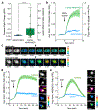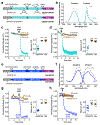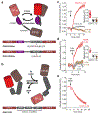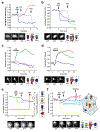Single-fluorophore biosensors for sensitive and multiplexed detection of signalling activities
- PMID: 30250062
- PMCID: PMC6258557
- DOI: 10.1038/s41556-018-0200-6
Single-fluorophore biosensors for sensitive and multiplexed detection of signalling activities
Abstract
Unravelling the dynamic molecular interplay behind complex physiological processes such as neuronal plasticity requires the ability to both detect minute changes in biochemical states in response to physiological signals and track multiple signalling activities simultaneously. Fluorescent protein-based biosensors have enabled the real-time monitoring of dynamic signalling processes within the native context of living cells, yet most commonly used biosensors exhibit poor sensitivity (for example, due to low dynamic range) and are limited to imaging signalling activities in isolation. Here, we address this challenge by developing a suite of excitation ratiometric kinase activity biosensors that offer the highest reported dynamic range and enable the detection of subtle changes in signalling activity that could not be reliably detected previously, as well as a suite of single-fluorophore biosensors that enable the simultaneous tracking of as many as six distinct signalling activities in single living cells.
Conflict of interest statement
COMPETING FINANCIAL INTERESTS
The authors declare no competing financial interests.
Figures







Similar articles
-
Single-color, ratiometric biosensors for detecting signaling activities in live cells.Elife. 2018 Jul 3;7:e35458. doi: 10.7554/eLife.35458. Elife. 2018. PMID: 29968564 Free PMC article.
-
Intensiometric biosensors visualize the activity of multiple small GTPases in vivo.Nat Commun. 2019 Jan 14;10(1):211. doi: 10.1038/s41467-018-08217-3. Nat Commun. 2019. PMID: 30643148 Free PMC article.
-
A genetically encoded fluorescent biosensor for detecting nitroreductase activity in living cancer cells.Anal Chim Acta. 2019 Dec 11;1088:131-136. doi: 10.1016/j.aca.2019.08.058. Epub 2019 Aug 28. Anal Chim Acta. 2019. PMID: 31623708
-
Redox biosensors in a context of multiparameter imaging.Free Radic Biol Med. 2018 Nov 20;128:23-39. doi: 10.1016/j.freeradbiomed.2018.04.004. Epub 2018 Apr 6. Free Radic Biol Med. 2018. PMID: 29630928 Review.
-
Visualizing dynamic activities of signaling enzymes using genetically encodable FRET-based biosensors from designs to applications.Methods Enzymol. 2012;504:317-40. doi: 10.1016/B978-0-12-391857-4.00016-1. Methods Enzymol. 2012. PMID: 22264542 Free PMC article. Review.
Cited by
-
Genetically encoded fluorescent biosensors illuminate kinase signaling in cancer.J Biol Chem. 2019 Oct 4;294(40):14814-14822. doi: 10.1074/jbc.REV119.006177. Epub 2019 Aug 21. J Biol Chem. 2019. PMID: 31434714 Free PMC article. Review.
-
Polarization of protease-activated receptor 2 (PAR-2) signaling is altered during airway epithelial remodeling and deciliation.J Biol Chem. 2020 May 8;295(19):6721-6740. doi: 10.1074/jbc.RA120.012710. Epub 2020 Apr 2. J Biol Chem. 2020. PMID: 32241907 Free PMC article.
-
Fluorescent biosensor imaging meets deterministic mathematical modelling: quantitative investigation of signalling compartmentalization.J Physiol. 2023 Oct;601(19):4227-4241. doi: 10.1113/JP282696. Epub 2023 Sep 25. J Physiol. 2023. PMID: 37747358 Free PMC article. Review.
-
Genetically encoded sensors towards imaging cAMP and PKA activity in vivo.J Neurosci Methods. 2021 Oct 1;362:109298. doi: 10.1016/j.jneumeth.2021.109298. Epub 2021 Jul 31. J Neurosci Methods. 2021. PMID: 34339753 Free PMC article. Review.
-
Two Novel Red-FRET ERK Biosensors in the 670-720nm Range.bioRxiv [Preprint]. 2024 Dec 2:2024.11.30.626109. doi: 10.1101/2024.11.30.626109. bioRxiv. 2024. PMID: 39677763 Free PMC article. Preprint.
References
Publication types
MeSH terms
Substances
Grants and funding
LinkOut - more resources
Full Text Sources
Other Literature Sources
Molecular Biology Databases
Research Materials

